
views
Purchasing a Watch

Decide between a new or used watch. Each has its advantages. New pocket watches are likely to work for a long time without trouble. They also represent the latest in pocket watch design. Used watches, on the other hand, offer a great variety of antique designs, motifs, and finishes. New watches are likely to be more expensive than used watches. However, collectable pocket watches, even if used, can still be pricey. Avoid buying used pocket watches over the Internet. In many cases, you won’t be able to tell how well it will work or its size.
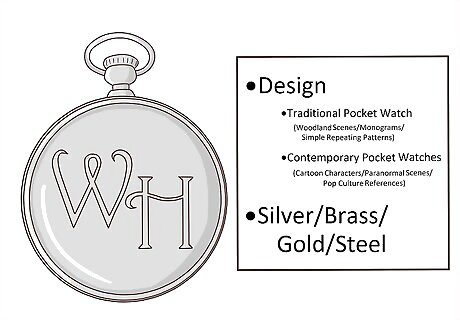
Select your preferred design and metal. Pocket watches come in an astounding variety of designs, so you should take your time finding the right one for you. There are also many materials watches are made of and finishes; pick the one that suits your tastes best. Traditional pocket watch designs usually contain things like woodland scenes, monograms, and simple repeating patterns. Contemporary watches feature more recent designs, like cartoon characters, paranormal scenes, and pop culture references. Silver is often preferred by modern buyers, as it goes well with most color combinations, is resilient, and has a lustrous finish. Other common metals include brass, gold, and steel.
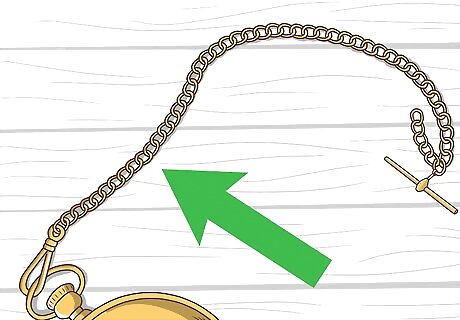
Buy a chain when necessary. Chain weight and weave are a matter of individual taste. A fine, thin chain is useful when dressing to the nines. Thick, durable chains are most suitable for day-to-day activities. Chains usually end in a claw, hook, or spring-loaded catch. These allow you to hook your pocket watch to a pocket, belt, or waist hem. Instead of a hook or catch, some chains end with a decorative fob, like a small metal medallion. This kind of chain works well with vests. Generally, the chain and watch should have the same finish. Choose a steel chain for steel watches, and so on.
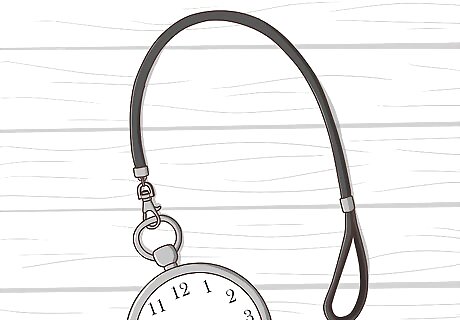
Add a strap or fob. If you plan to wear your pocket watch in a pants pocket instead of in a vest, consider attaching a leather strap or watch fob to it. These are generally sturdier than watch chains, and convey a rugged, casual look. You can also purchase a leather holder to attach to your belt loop. This will hold the watch outside your pants for a bolder statement.
Including a Pocket Watch in Outfits
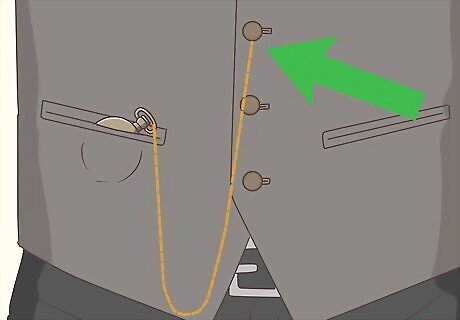
Wear your watch traditionally. Sometimes also called “the classic,” this look has the pocket watch carried in vest pocket. The watch chain is usually passed through a buttonhole and then draped in the opposite pocket or clipped to that pocket. If you are right-handed, the watch should go in your left vest pocket, and vice versa. This allows you to draw the watch while leaving your dominant hand free. Some wearers of the classic loop the chain around a button after passing it through a buttonhole. This version is ideal for displaying decorative chain fobs.
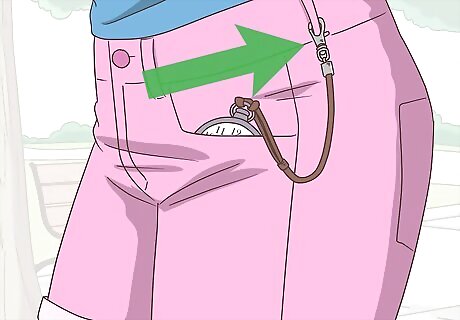
Keep your watch in a pants pocket for a casual look. Your watch might also work well in the pocket of a pair of shorts. The chain can clip to the top of the pocket, the waistline, or a belt loop. This look works best with watches that have a larger face. Watches with a smaller face or ornate designs on the face can be difficult to read. Unless the chain is long, you'll need to unhooking it for a closer look.

Carry watches in a work clothes pocket. Pocket watches were never just the domain of the rich. Although that is how we perceive them today, there was a time when anyone whose job required them to know the time carried a pocket watch. Try an unusual retro look with overalls. Your pocket watch will go in the front bib pocket. Chains with fobs can be wrapped around an overall button; clips can attach to a hemline. This look works best with a rugged, heavy chain. A heavy chain will also be able to stand up to the abuse of heavy work best. Complete your ensemble with a loose-fit collared work shirt, a newsboy cap, and chunky construction boots.

Use your pocket watch to add theatrical flair to outfits. Because a pocket watch is such a bold statement, it can be a useful accessory for themed outfits. Watches can be stowed in the pockets of costumes, cosplay outfits, or to show your membership in a subculture. The kind of outfit will determine where you attach the hook or fob of the watch. Hemlines are sturdy, which works great for hooks. Fobs can pass through buttonholes and around buttons. An unusual fob or chain can really spice up your everyday watch and chain, which will make it seem like a natural part of the costume. Since pocket watches are associated with wealth and conservatism, try wearing one in the jeans vest of a punk outfit to make a statement.

Wear watches like a necklace for feminine appeal. When pocket watches started becoming more affordable in the mid 1800s, women wore smaller watches as necklaces. Replace your chain with some ribbon and tie a simple knot to make a pocket watch necklace. Slide chains were also popular for turning pocket watches into necklaces. Being more ornate, slide chains are ideal for formal events. Unless the ribbon or chain is especially long, it'll be difficult to read your pocket watch while wearing it as a necklace, but at least you'll have a unique necklace.
Maintaining Your Watch
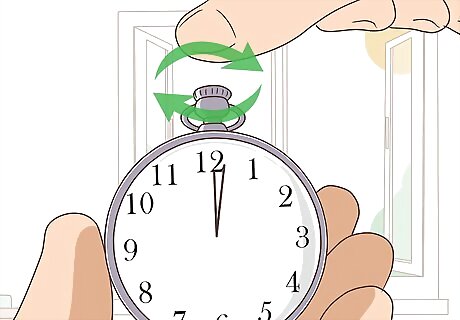
Wind mechanical watches. All but the newest pocket watches will run between 24 and 28 hours per wind. High-grade and newer models can last between 36 and 48 hours. Regardless of what type of pocket watch you own, most springs are intended to be wound daily. Try to wind your watch every morning or evening so it becomes part of your daily routine. You’ll be less likely to forget to wind your watch this way. Stem-wind watches are wound by twisting the ridged crown at the top of the stem, usually in a clockwise direction. As it winds, you should hear a clicking, “ratcheting” noise. Key-wind watches will have a small hole inside the inner lid of the watch case. In the hole will be a square metal winding arbor (similar to a peg). A key goes on the arbor to wind the watch.
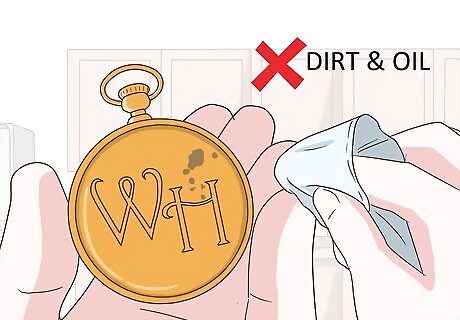
Wipe off dirt and oil from your watch on a regular basis. A soft, lint-free cloth, like one made from microfiber, is suitable for gently lifting skin oil and dirt off of metal surfaces. Buff the watch with the cloth to clean the metal. Do this every time you are done wearing it. When the metal of your watch dulls or tarnishes, use a tiny bit of suitable metal cleaner while buffing with a soft, lint-free cloth. Remember to wipe down the inside faces of the watch and its case with your dry cloth. If your watch case has hinges, gunk tends to accumulate here.

Polish your watch when necessary. Many watches tarnish or become scuffed around the edges, though many of these imperfections can be removed with polishing. Buy some metal polish and use a soft, lint free cloth to gently clean the watch according to the polish directions. Polish is generally formulated for a specific kind of metal, so you’ll need to know what your watch is made of before polishing it. If you don’t know the material your watch is made of, take it to a jeweler or watch repair person to find out. While you're at it, ask what kind of polish you should use to clean your watch at home. If your watch has grooved etching or engraving on it, clean these with polish as well. Cotton swabs are useful for dealing with nooks and crannies.
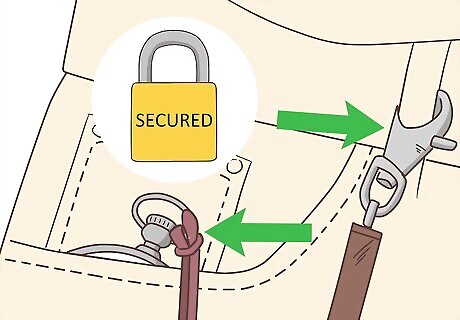
Use a chain and fob regularly to keep your watch safe. Always make sure the watch fob or chain is securely attached to the watch before wearing it out. The other end of the fob should be hooked to a hemline or a sturdy part of your clothing (like belt loops).

Take broken watches to be repaired. Heirloom watches may not always work, or may work inconsistently. The internal workings of pocket watches are very delicate, so you should always take broken ones to a respected watch repair person or jeweler. Some mail-in watch repair services offer competitive rates, but you should always verify that it's well respected. Be on the lookout for bad reviews and customer complaints. Many, though not all, jewelers also repair timepieces, like pocket watches. Look up local jewelers online and call to ask if they can fix your watch. Broken or irregularly running pocket watches can still be worn as accessories, but it’s likely you’ll feel silly when you “check the time.”
















Comments
0 comment